Guinea pigs are excellent pets, they are adorable, friendly, and easy to take care of. This is true for every breed, including our hairless guinea pigs! Hairless guinea pigs have been growing in popularity due to their unusual looks and cuteness. They are active and curious pets that can with proper care and patience form meaningful relationships with their owners.
There are two types of hairless guinea pigs called the Baldwin guinea pig and the Skinny pig. Neither of these hairless guinea pig breeds has occurred naturally but they are actually the result of a genetic mutation developed by people in the scientific community, as well as guinea pig breeders.
Table of Content
Hairless Guinea Pigs | Everything You Need to Know!
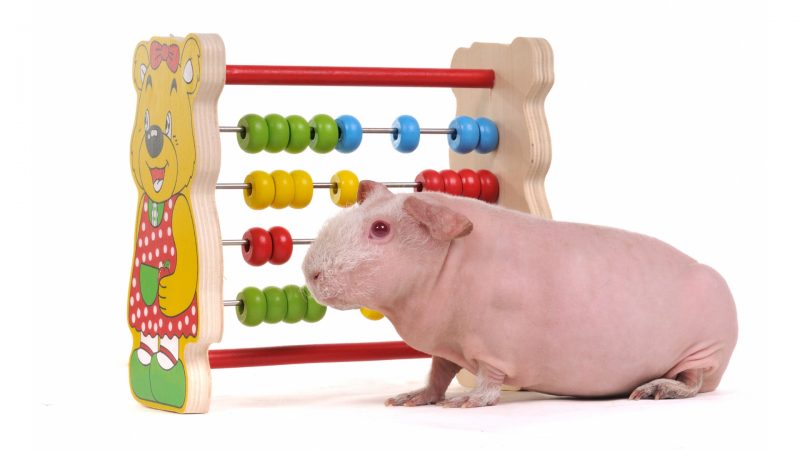
Why Are Some Guinea Pigs Hairless?
Hairless guinea pigs have no hair due to a genetic mutation that occurred in recent decades while breeding different guinea pigs for scientific research. While genetic mutations occur naturally in the wild, they usually don’t become prominent, especially when the mutation doesn’t benefit the animal.
However, because guinea pigs are domesticated animals, humans play a large role in following special or unusual genetic strains. Because the majority of guinea pig enthusiasts reacted positively to these specific hairless breeds, they continued to breed them. This is how they became a relevant and very interesting guinea pig breed.
What Are the Breeds of a Hairless Guinea Pig?
There are two types of hairless guinea pigs, they are called the Baldwin guinea pig and the Skinny pig. Both breeds come in a variety of colors and patterns. However, there are some minor differences.
Can Hairless Guinea Pigs Grow Hair?
After they’ve reached maturity, hairless guinea pigs will not grow new hair. Keep in mind that Baldwin guinea pigs are born with hair and they lose it after a few months, while Skinny pigs retain hair on their legs, feet, and noses.
How Long Do Hairless Guinea Pigs Live?
Hairless guinea pigs live an average of 6-8 years. With exceptional care and a bit of luck, they can live even longer. For reasons that are still unclear, hairless guinea pigs tend to live longer than their long-haired counterparts.
Are Hairless Guinea Pigs Good Pets?
Hairless guinea pigs make for excellent pets. They are interested in the world around them, are relatively low-maintenance, and can form special bonds with people.
Hairless guinea pigs are amazing pets for people with allergies. Pet hair allergies keep many potential pet owners from having animals in their homes. Fortunately, hairless guinea pigs are a great allergy-free alternative.
Hairless Guinea Pig Care Sheet
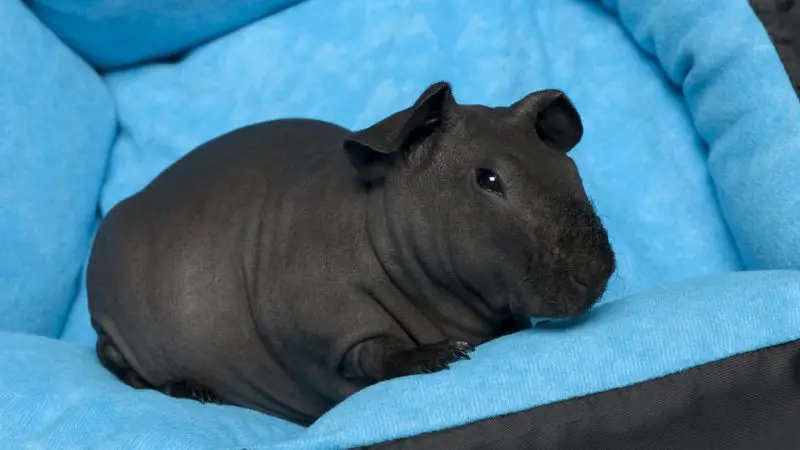
Hairless guinea pig care is similar to that of standard guinea pig breeds, but with a few additional responsibilities.
Housing Your Hairless Guinea Pig
It’s important to know that hairless guinea pigs should only be housed indoors. Because they lack a fur coat, they aren’t able to regulate their body temperature like regular guinea pigs.
The ideal temperature for hairless breeds is between 75 and 79°F (23 to 26°C). Be careful not to place your hairless guinea pig’s cage in drafty areas of your home, as they get cold easily.
Like other breeds of guinea pigs, hairless guinea pigs are the happiest and healthiest when they have at least one cage mate. All guinea pigs are social animals, and will not thrive when they are housed alone.
It’s normal to house hairless breeds with other types of guinea pigs. Just be sure to keep an extra close eye on your hairless guinea pigs if they get into a scuffle, as they don’t have hair to protect them against bites and scratches.
Make sure that your hairless guinea pig has a large enough cage, so it can get plenty of exercises. Skinny pigs, in particular, tend to be more active than their furry cousins. Make sure your pet’s enclosure is at least 4 ft x 2 ft (120cm x 60cm).
Feeding of Hairless Guinea Pigs
Hairless guinea pigs eat the same diet as other types of guinea pigs but consume slightly more due to their high metabolism. You can expect that hairless guinea pigs will eat about 1/3 more food than other breeds.
Their main sources of nutrition should be vegetables, especially cruciferous and root vegetables. There are also pellets made especially for guinea pigs that can be found at your local pet store. Generally, it’s best for your hairless guinea pig if he gets his nutrition from a variety of sources.
Skin Care of Hairless Guinea Pigs
It’s important to pay special attention to your hairless guinea pig’s skin. It is common for their skin to need extra care and protection from environmental elements. If your hairless guinea pig is going to be spending time out in the sun, it’s important to apply sunscreen to its sensitive skin so it doesn’t burn.
With the exception of sunscreen, most hairless guinea pigs don’t need additional skin care. However if dry and flakey skin seems to be an issue, it’s fine to apply unscented baby lotion to your hairless guinea pig’s skin. Just remember that guinea pigs, even hairless ones, lick themselves on a regular basis to keep clean. So, it’s important to make sure you’re using natural and sensitive products with the lowest number of ingredients.
Grooming Routines of Hairless Guinea Pigs
Although brushing your hairless guinea pig isn’t necessary, you should still follow a grooming routine. Be sure to inspect your hairless guinea pig’s skin for mites and skin infections. It’s important to make sure your pet’s nails are trimmed, and that its teeth are not becoming overgrown.
You can use regular nail clippers to trim your guinea pig’s nails. However, it’s important that you don’t cut them too short. If you cut too high, you could injure your pet. If you feel unsure, contacting your veterinarian is always your best bet.
To prevent your animal’s teeth from getting too long, make sure you provide it with plenty of things to chew on. Things like twigs and woodchips will help keep his teeth at a comfortable length.
Bathing Your Hairless Guinea Pigs
Hairless guinea pigs rarely need a bath. Bathing your hairless friend can strip his skin of natural oils and lead to dryness. If you decide your pet needs a bath, fill a small bowl with a bit of warm water. Be sure not to make it too full as your guinea pig should be able to comfortably stand in the water.
Use a drop of animal shampoo and gently run over its skin with a soft cloth. Be sure to dry your hairless guinea pig with a towel immediately after taking it out of the water. If the hairless guinea pig becomes too cold, it could get sick.
Baby Hairless Guinea Pig Care
When hairless guinea pig babies are born, they already have their eyes open. Within a short time, they will be moving around on their own, drinking milk, and eating hay. This makes caring for babies relatively easy. However, as with adult hairless guinea pigs, it’s important to make sure that hairless guinea pig babies are kept warm.
If you have trouble maintaining an ideal temperature in the room, there are pet-safe heating pads available that are specially designed for small animals.
Skinny Guinea pig vs. Baldwin Guinea Pig
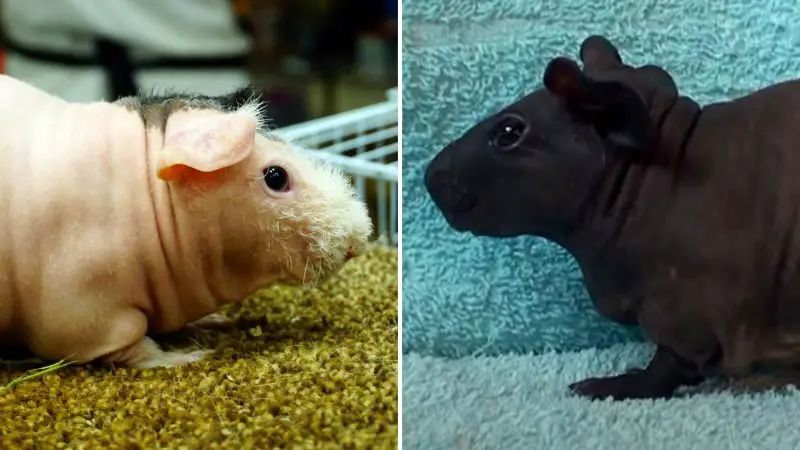
While Skinny pigs and Baldwins require the same care, they are different in appearance. Skinny pigs can be recognized by the remaining hair on their snouts, legs, and feet. Baldwin adults are completely hair-free except for their whiskers.
The exception is young Baldwins, who are born with hair but slowly lose it entirely in the first few months of their life. Both animals are a pleasure to keep as a pet. Which breed you are going to choose will simply depend on personal preference.
What Is a Skinny Guinea Pig?
Guinea pigs have long been bred in laboratories and used as test subjects for experiments. In 1978, a Canadian laboratory discovered a genetic mutation in their guinea pigs. The mutation caused hairlessness or baldness, which continued to emerge in subsequent generations.
The lab made an effort to continue breeding the hairless guinea pigs until an entirely new breed was developed. They are now famously known as Skinny pigs! Skinny pigs are not completely hairless as they have a bit of fur on their muzzles, legs, and feet.
What Is a Baldwin Guinea Pig?
Baldwin guinea pigs are also a result of a genetic mutation. Only this time, the anomaly occurred at a guinea pig breeding center of White Crested guinea pigs in California.
Baldwins are born with fur but they slowly begin losing it when they are just a few days old. After 3 to 4 months, they become completely hairless.
Different Colors of Hairless Guinea Pigs
Just like their furry relatives, hairless guinea pigs also come in a variety of colors. These are the most common ones:
- Black hairless guinea pigs – They have a special sheen to their skin, which is popular with many pet owners.
- Gray hairless guinea pig – They are affectionate and known for their resemblance to hippopotamuses!
- Brown and golden hairless guinea pigs – This variety is especially cute, as they often come in a tortoiseshell pattern.
- White hairless guinea pigs – They appear pink in color. Some may even be albino. These hairless guinea pigs truly resemble little piglets.
Hairless Guinea Pig Price | Do They Cost More Than Other Breeds?
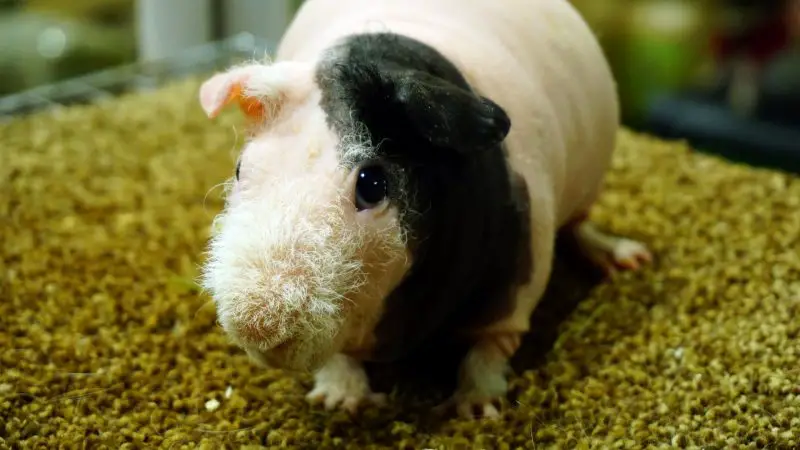
Hairless guinea pigs cost significantly more than standard breeds. Standard guinea pigs cost anywhere from $10 to $40, while hairless breeds can cost around $150.
Where to Buy Hairless Guinea Pigs?
Hairless guinea pigs can be found at pet stores, although not all pet stores will have this special breed. Many people who are interested in hairless guinea pigs will find their perfect pet by contacting a breeder or guinea pig rescue organization.
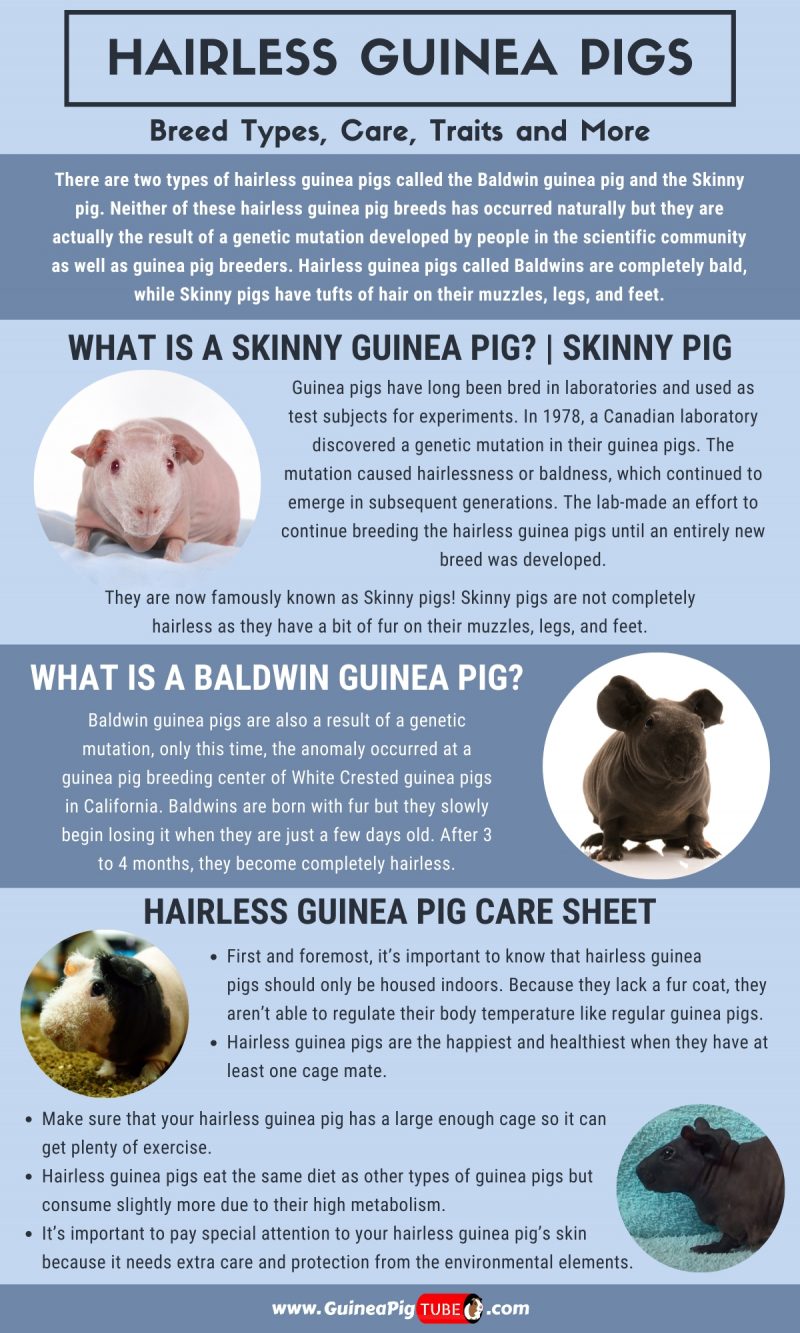
Summary
It’s no wonder that hairless guinea pigs continue to grow in popularity. Their good-natured personalities paired with a one-of-a-kind look make them irresistible to many pet owners.
If you’re ready to give special care to a unique and wonderful pet, a hairless guinea pig may be exactly what you’re looking for. For more guinea pig-related content please keep following our site!
List of Sources
Temperature Preference in IAF Hairless and Hartley Guinea Pigs (Cavia Porcellus)
Karyotype of Hairless Guinea Pig
Development of Hairless Laboratory Guinea Pigs: The Biological Studies
Hairless Pigmented Guinea Pigs: A New Model for the Study of Mammalian Pigmentation
Hairless Guinea Pig Skin: Anatomical Basis for Studies of Cutaneous Biology
